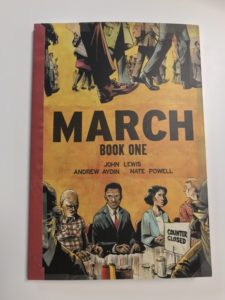I’ve recently taken to enjoying strolls through our local Barnes and Noble. In just the past few months, I’ve been surprised at the kinds of books that jump out to me – books I wouldn’t have ever though to check out on my own. You never know what you’ll find when you’re not looking for anything.
 Today was one of those days where I found a real gem. As I walked past the store’s section for Black History Month, I saw some of the books which one might come to expect today; The Warmth of Other Suns by Isabel Wilkerson, memoirs of Rosa Parks, books by or about Dr. King. One book stuck out to me – March by Congressman John Lewis and Andrew Aydin (illustrated by Nate Powell).
Today was one of those days where I found a real gem. As I walked past the store’s section for Black History Month, I saw some of the books which one might come to expect today; The Warmth of Other Suns by Isabel Wilkerson, memoirs of Rosa Parks, books by or about Dr. King. One book stuck out to me – March by Congressman John Lewis and Andrew Aydin (illustrated by Nate Powell).
March is a graphic novel series, of which I have now read the first of three volumes. It tells the story of the Civil Rights Movement through the eyes of John Lewis. The black and white art is visually striking, and adds to the dynamic story telling of Lewis and Aydin. It was a book I could not put down.
The story begins with a scene of marchers crossing the Edmund Pettus Bridge in Selma, Alabama on March 7, 1965 – Bloody Sunday. It then fast forwards to John Lewis on the day of President Barack Obama’s inauguration (January 20, 2009). From there, the story moves in and out from the present to past events of Lewis’ life; events that shaped him as a boy up through some of the first protests of the Civil Rights Movement. The reader truly comes to feel how President Obama’s inauguration would have meant so much to Lewis’s generation – and why Trump’s presidency could feel like such a large step backwards.
One of the things that struck me about the novel is how it was able to incorporate so much historical information that was of great benefit to me. I learned more about not only John Lewis himself, but also other movement leaders like Jim Lawson and the Fellowship of Reconciliation (F.O.R.). Dr. King himself is mentioned a handful of times as an iconic, heroic figure in the background – it makes me think of Iron Man’s appearances in the recent Spider Man movie and the reverence young Peter Parker had for Tony Stark.
Another section of the story which caused me to spend some time reflecting about my own life was Lewis’ discussion on how much the social gospel impacted him as a teenager. On pages 54-56, he discusses how the black preacher at his church never mentioned the injustices being committed against the African American community (yet, of course, he always drove away in a very nice automobile!). It was upon hearing Dr. King speak for the first time on the radio where he was introduced to the social gospel, and he heard for the first time a man apply “the principles of the church to what was happening now.“
Of course, I find the social gospel to be theologically inadequate, as I do not believe it properly communicates the story of redemption laid out for us in the Bible. Yet, before I critique movements like the social gospel I must ask myself the question, “Is my gospel making a difference to what is happening to people now?” In other words, am I applying the hope of redemption to the problems of people today – whether that is our modern epidemic of depression/anxiety, the issues of systemic racism, or the coverups of abuse happening all around us? Is the message I preach actually making a difference in the lives of people in this life, or is it simply a free bus pass to heaven when they die?
About halfway through the story, the novel mentions a comic book which came out near the beginning of the Civil Rights Movement called Martin Luther King and the Montgomery Story. This comic book explained the basics of passive resistance and non-violent action for a young generation of fighters and dreamers. It is clear that March intends to bring the legacy of the Civil Rights Movement – with its heroes as well as its failures – to a new generation of fighters and dreamers today.
I believe March fulfills its purpose, but it also adds something unique to the material out there on the Civil Rights Movement. It is as visually striking as the movies and documentaries (such as Selma) while still containing as much historical information as many books available today.
I am looking forward to purchasing the next two volumes and reflecting more on the life and work of John Lewis and other heroic figures. If you’re looking for something to read during Black History Month, I want to commend March to you. I do not think you’ll be disappointed.
